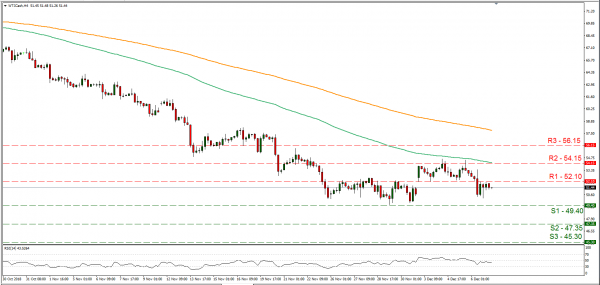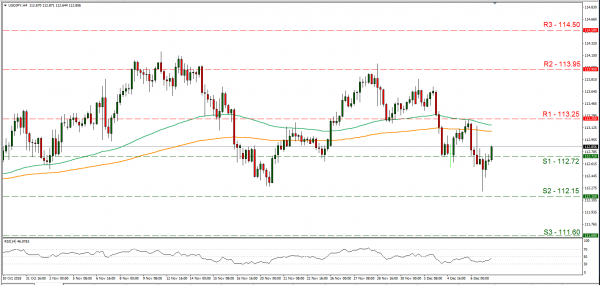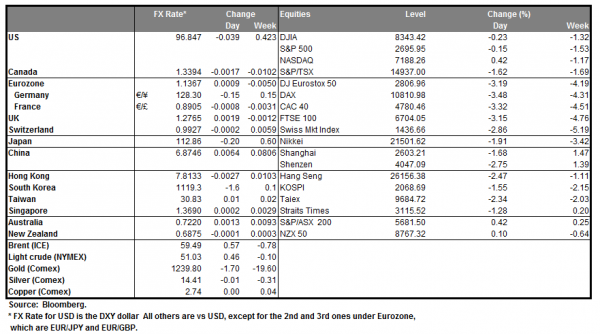The USD weakened yesterday, as the US Treasury bond yields dropped and the fears of a possible reigniting of the US-Sino trade wars sparked. After the uneasy 90 day truce being agreed at the G20 meeting between US president Trump and Chinese president Xi, Canadian authorities arrested the CFO of Huawei, a large Chinese company, at the request of the US. The arrest spread fear among investors, for a possible escalation of the US-Sino trade frictions but the White House distanced itself from the arrest. On other news, the USD weakened as US bond yields kept falling yesterday and there was renewed speculation of a possible imminent pause in the Fed’s tightening cycle, after a possible December rate hike. We expect today’s US employment report to be under the market’s watchful eye for further indications affecting the Fed’s future intentions.
USD/JPY dropped yesterday breaking the 112.72 (S1) support line, however regained some of the lost ground during the Asian session today. We maintain a bearish bias for the pair’s direction, as a downward trendline could be forming since the 30th of November, however the pair’s direction could be dependent on a number of issues as mentioned in the fundamental analysis. Should the pair’s direction be dictated by the bulls of the market, we could see the pair breaking the 113.25 (R1) resistance line, while if the bears take over, we could see the pair breaking the 112.72 (S1) support line and aim for the 112.15 (S2) support line.
OPEC negotiations to linger on
OPEC concluded its meeting yesterday, without reaching an agreement as Russia is in disagreement about the discussed oil production cuts. According to media reports, Saudi energy minister stated that he isn’t confident of an agreement in the next day of the negotiations. Analysts still expect some kind of production cuts to be announced, however pointed out that Russia remains the sticking point to an agreement, underscoring the Non-OPEC member’s influence. On other news, the US announced that it has turned into a net oil exporter for the first time in over 75 years. Negotiations are expected to continue today in Vienna and the oil market could experience renewed volatility.
WTI’s prices yesterday, dropped breaking the 52.10 (R1) support line (now turned to resistance), regained some ground later on, however proved unable to break above the 52.10 (R1) resistance line. We continue to regard oil prices as sensitive to any decision taken at the OPEC+ meeting (probably today), despite the wait and see position of the oil market over the past few days. Should the market favor the pair’s short position, we could see it breaking the 49.40 (S1) support level and aim for the 47.35 (S2) support barrier. On the other hand should the bulls take over, we could see oil prices breaking the 52.10(R1) resistance line and aim for the 54.15 (R2) resistance hurdle.
In today’s other economic highlights:
In today’s European session, we get Germany’s industrial output growth rate for October. In the American session from the US we get the US employment report with the NFP figure, the unemployment rate and the average earnings growth rate. Furthermore from the US we get the preliminary U. Michigan Sentiment for December and the Baker Hughes oil rig count figure. Staying in the America’s, we get Canada’s unemployment data for November. As for speakers, ECB’s Benoit Coeure (08:30, GMT) and Fed’s Lael Brainard (17:00, GMT) speak.
WTI H4
Support: 49.40 (S1), 47.35 (S2), 45.30 (S3)
Resistance: 52.10 (R1), 54.15 (R2), 56.15 (R3)
USD/JPY H4
Support: 112.72 (S1), 112.15 (S2), 111.60 (S3)
Resistance: 113.25 (R1), 113.95 (R2), 114.50 (R3)


















